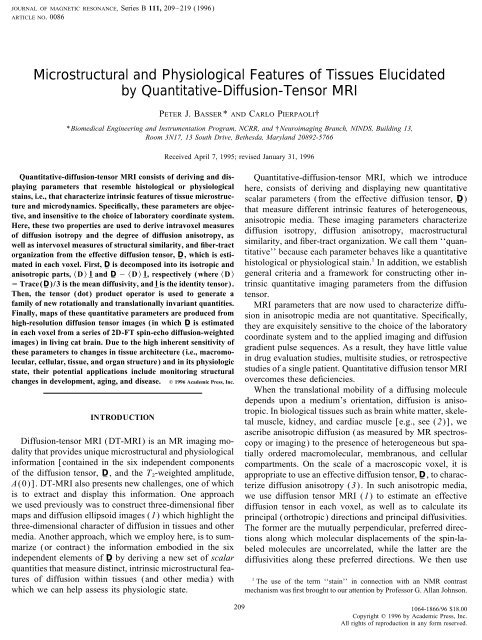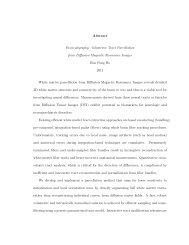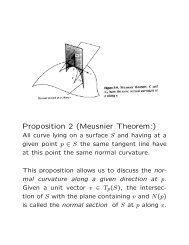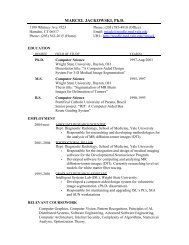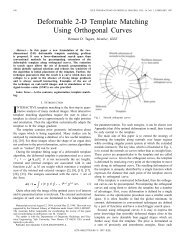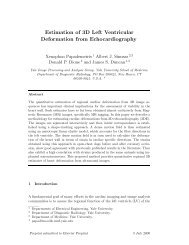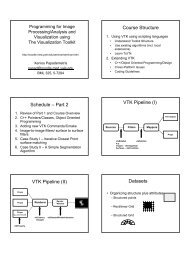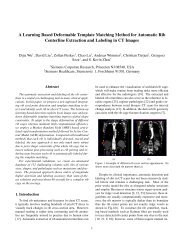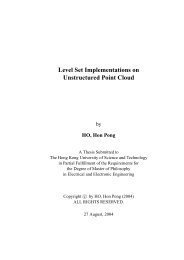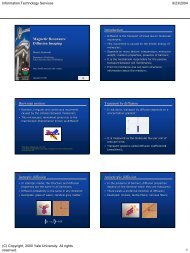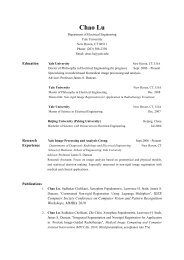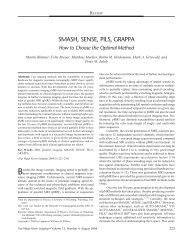Microstructural and Physiological Features of Tissues Elucidated by ...
Microstructural and Physiological Features of Tissues Elucidated by ...
Microstructural and Physiological Features of Tissues Elucidated by ...
You also want an ePaper? Increase the reach of your titles
YUMPU automatically turns print PDFs into web optimized ePapers that Google loves.
JOURNAL OF MAGNETIC RESONANCE, Series B 111, 209–219 (1996)<br />
ARTICLE NO. 0086<br />
<strong>Microstructural</strong> <strong>and</strong> <strong>Physiological</strong> <strong>Features</strong> <strong>of</strong> <strong>Tissues</strong> <strong>Elucidated</strong><br />
<strong>by</strong> Quantitative-Diffusion-Tensor MRI<br />
PETER J. BASSER* AND CARLO PIERPAOLI†<br />
*Biomedical Engineering <strong>and</strong> Instrumentation Program, NCRR, <strong>and</strong> †Neuroimaging Branch, NINDS, Building 13,<br />
Room 3N17, 13 South Drive, Bethesda, Maryl<strong>and</strong> 20892-5766<br />
Received April 7, 1995; revised January 31, 1996<br />
Quantitative-diffusion-tensor MRI consists <strong>of</strong> deriving <strong>and</strong> dis- Quantitative-diffusion-tensor MRI, which we introduce<br />
playing parameters that resemble histological or physiological here, consists <strong>of</strong> deriving <strong>and</strong> displaying new quantitative<br />
stains, i.e., that characterize intrinsic features <strong>of</strong> tissue microstructure<br />
<strong>and</strong> microdynamics. Specifically, these parameters are objective,<br />
<strong>and</strong> insensitive to the choice <strong>of</strong> laboratory coordinate system.<br />
Here, these two properties are used to derive intravoxel measures<br />
<strong>of</strong> diffusion isotropy <strong>and</strong> the degree <strong>of</strong> diffusion anisotropy, as<br />
well as intervoxel measures <strong>of</strong> structural similarity, <strong>and</strong> fiber-tract<br />
organization from the effective diffusion tensor, DW , which is esti-<br />
scalar parameters (from the effective diffusion tensor, DW )<br />
that measure different intrinsic features <strong>of</strong> heterogeneous,<br />
anisotropic media. These imaging parameters characterize<br />
diffusion isotropy, diffusion anisotropy, macrostructural<br />
similarity, <strong>and</strong> fiber-tract organization. We call them ‘‘quan-<br />
titative’’ because each parameter behaves like a quantitative<br />
histological or physiological stain. 1 mated in each voxel. First, DW is decomposed into its isotropic <strong>and</strong><br />
anisotropic parts, »D… IW <strong>and</strong> DW 0 »D… IW , respectively (where »D…<br />
In addition, we establish<br />
general criteria <strong>and</strong> a framework for constructing other in-<br />
Å Trace(DW )/3 is the mean diffusivity, <strong>and</strong> IW is the identity tensor). trinsic quantitative imaging parameters from the diffusion<br />
Then, the tensor (dot) product operator is used to generate a tensor.<br />
family <strong>of</strong> new rotationally <strong>and</strong> translationally invariant quantities.<br />
Finally, maps <strong>of</strong> these quantitative parameters are produced from<br />
high-resolution diffusion tensor images (in which DW is estimated<br />
in each voxel from a series <strong>of</strong> 2D-FT spin-echo diffusion-weighted<br />
images) in living cat brain. Due to the high inherent sensitivity <strong>of</strong><br />
these parameters to changes in tissue architecture (i.e., macromo-<br />
lecular, cellular, tissue, <strong>and</strong> organ structure) <strong>and</strong> in its physiologic<br />
state, their potential applications include monitoring structural<br />
changes in development, aging, <strong>and</strong> disease. 1996 Academic Press, Inc.<br />
MRI parameters that are now used to characterize diffusion<br />
in anisotropic media are not quantitative. Specifically,<br />
they are exquisitely sensitive to the choice <strong>of</strong> the laboratory<br />
coordinate system <strong>and</strong> to the applied imaging <strong>and</strong> diffusion<br />
gradient pulse sequences. As a result, they have little value<br />
in drug evaluation studies, multisite studies, or retrospective<br />
studies <strong>of</strong> a single patient. Quantitative diffusion tensor MRI<br />
overcomes these deficiencies.<br />
When the translational mobility <strong>of</strong> a diffusing molecule<br />
depends upon a medium’s orientation, diffusion is aniso-<br />
INTRODUCTION<br />
tropic. In biological tissues such as brain white matter, skeletal<br />
muscle, kidney, <strong>and</strong> cardiac muscle [e.g., see (2)], we<br />
ascribe anisotropic diffusion (as measured <strong>by</strong> MR spectros-<br />
Diffusion-tensor MRI (DT-MRI) is an MR imaging modality<br />
that provides unique microstructural <strong>and</strong> physiological<br />
information [contained in the six independent components<br />
<strong>of</strong> the diffusion tensor, DW , <strong>and</strong> the T2-weighted amplitude,<br />
A(0)]. DT-MRI also presents new challenges, one <strong>of</strong> which<br />
is to extract <strong>and</strong> display this information. One approach<br />
we used previously was to construct three-dimensional fiber<br />
maps <strong>and</strong> diffusion ellipsoid images (1) which highlight the<br />
three-dimensional character <strong>of</strong> diffusion in tissues <strong>and</strong> other<br />
media. Another approach, which we employ here, is to summarize<br />
(or contract) the information embodied in the six<br />
independent elements <strong>of</strong> DW <strong>by</strong> deriving a new set <strong>of</strong> scalar<br />
quantities that measure distinct, intrinsic microstructural fea-<br />
copy or imaging) to the presence <strong>of</strong> heterogeneous but spa-<br />
tially ordered macromolecular, membranous, <strong>and</strong> cellular<br />
compartments. On the scale <strong>of</strong> a macroscopic voxel, it is<br />
appropriate to use an effective diffusion tensor, DW , to characterize<br />
diffusion anisotropy (3). In such anisotropic media,<br />
we use diffusion tensor MRI (1) to estimate an effective<br />
diffusion tensor in each voxel, as well as to calculate its<br />
principal (orthotropic) directions <strong>and</strong> principal diffusivities.<br />
The former are the mutually perpendicular, preferred direc-<br />
tions along which molecular displacements <strong>of</strong> the spin-la-<br />
beled molecules are uncorrelated, while the latter are the<br />
diffusivities along these preferred directions. We then use<br />
tures <strong>of</strong> diffusion within tissues (<strong>and</strong> other media) with<br />
which we can help assess its physiologic state.<br />
1<br />
The use <strong>of</strong> the term ‘‘stain’’ in connection with an NMR contrast<br />
mechanism was first brought to our attention <strong>by</strong> Pr<strong>of</strong>essor G. Allan Johnson.<br />
209 1064-1866/96 $18.00<br />
Copyright 1996 <strong>by</strong> Academic Press, Inc.<br />
All rights <strong>of</strong> reproduction in any form reserved.
210 BASSER AND PIERPAOLI<br />
FIG. 1. (a) T 2-weighted image showing regions <strong>of</strong> gray matter, white matter, <strong>and</strong> CSF-filled ventricles in in vivo cat brain. (b) Diffusion ellipsoid<br />
image constructed from the effective diffusion tensor, DW , estimated in each voxel for the ROI enclosed <strong>by</strong> the white rectangle.<br />
these quantities to derive measures <strong>of</strong> diffusion isotropy, matter fiber tracts are packed in orderly bundles), but should<br />
diffusion anisotropy, macrostructural similarity, <strong>and</strong> fiber- show no fiber-tract organization in voxels containing isotract<br />
organization. tropic media, such as gray matter <strong>and</strong> CSF-filled ventricles.<br />
To make the qualitative differences between these terms In summary, these new one-dimensional (scalar) measures<br />
clear, consider the T2-weighted image <strong>of</strong> living cat brain would provide new information about the three-dimensional<br />
in Fig. 1a <strong>and</strong> the corresponding diffusion ellipsoid image character <strong>of</strong> diffusion in anisotropic tissues, information that<br />
(constructed for an ROI containing the internal capsule) in has not been available using other MRI techniques.<br />
Fig. 1b. In principle, an image <strong>of</strong> a diffusion anisotropy We expect these parameters to be useful in elucidating<br />
index <strong>of</strong> this ROI should show the same contrast in voxels structural features in normal, diseased, or degenerating tis-<br />
containing similar types <strong>of</strong> white matter, irrespective <strong>of</strong> their sues. The transformation <strong>of</strong> less-ordered to ordered, complex<br />
fiber-tract direction. This is because an anisotropy index structures is a characteristic <strong>of</strong> normal development. This<br />
should measure the degree <strong>of</strong> preferential mobility within a transformation occurs at a variety <strong>of</strong> length scales, including<br />
voxel, but should be insensitive to the direction along which macromolecular (e.g., in neur<strong>of</strong>ilaments <strong>and</strong> microtubules),<br />
diffusion is preferred. Geometrically, it should characterize cellular (e.g., in axons), tissue (e.g., in skeletal muscle,<br />
the shape <strong>of</strong> the diffusion ellipsoid, but not its size or orienta- tendons, ligaments, <strong>and</strong> lens), <strong>and</strong> organ (e.g., in brain white<br />
tion. A measure <strong>of</strong> macrostructural (diffusive) similarity matter, heart, <strong>and</strong> kidney). Moreover, preliminary findings<br />
should identify tissues with a similar microstructure, spe- that diffusion-weighted images are sensitive to architectural<br />
cifically with similar principal directions <strong>and</strong> principal diffu- changes in the optic nerve prior to myelin deposition (4)<br />
sivities. We expect that such a measure would be large in suggest that these new parameters could be useful in asgray<br />
matter <strong>and</strong> larger still in the CSF-filled ventricles sessing <strong>and</strong> characterizing normal <strong>and</strong> pathological develop-<br />
(where diffusion is largely isotropic), but it would not neces- mental processes. Interest continues to grow in assessing<br />
sarily be large in regions containing white-matter fibers developmental changes, particularly when induced <strong>by</strong> ge-<br />
whose fiber direction is changing. Geometrically, a measure netic manipulation or environmental stress. Noninvasive <strong>and</strong><br />
<strong>of</strong> structural similarity should measure the similarity <strong>of</strong> the nondestructive MRI techniques that can sense these changes<br />
shape, size, <strong>and</strong> orientation <strong>of</strong> different diffusion ellipsoids. may become increasingly valuable in such basic studies.<br />
Our definition <strong>of</strong> fiber-tract organization combines notions Conversely, the loss or lack <strong>of</strong> organization <strong>and</strong> structure<br />
<strong>of</strong> diffusion anisotropy <strong>and</strong> macrostructural similarity. Fiber- at the molecular, cellular, tissue, <strong>and</strong> organ length scales is<br />
tract organization is a property that we wish to ascribe only a characteristic <strong>of</strong> abnormal development, aging, or degener-<br />
to anisotropic media (like white matter) but not to isotropic ation. For example, cardiac muscle fiber disorganization ac-<br />
media (like the CSF-filled ventricles or most gray matter). companies idiopathic cardiac myopathy <strong>and</strong> is believed to<br />
Essentially, this parameter should measure the macrostruc- contribute to the loss <strong>of</strong> mechanical stiffness <strong>and</strong> pumping<br />
tural similarity <strong>of</strong> the anisotropic part <strong>of</strong> the diffusion tensor efficiency <strong>of</strong> the heart (5). A measure <strong>of</strong> the degree <strong>of</strong> fiber<br />
in different voxels. Such a measure should highlight regions disorganization may be useful in diagnosing such patholo-<br />
like the corpus callosum or the optical tract (where white-gies,<br />
as also described <strong>by</strong> Wedeen et al. (6). Tumors in
TISSUE STRUCTURE FROM QUANTITATIVE-DIFFUSION-TENSOR MRI<br />
white matter <strong>and</strong> muscle are also more disorganized than DWIs using a model that may assume diffusion is isotropic.<br />
the surrounding normal tissues; a parameter that measures Even so, these anisotropy measures suffer from a more seri-<br />
fiber organization may help to demarcate (segment) these ous failing: They inherently depend on (a) the choice <strong>of</strong> the<br />
domains. Therefore, objective parameters that measure mi- laboratory frame <strong>of</strong> reference (i.e., the x, y, z coordinate<br />
crostructural features nondestructively <strong>and</strong> noninvasively system used to represent the directions <strong>of</strong> the static B field<br />
may also be <strong>of</strong> clinical use.<br />
<strong>and</strong> the applied magnetic field gradients in an MR experi-<br />
ment); (b) the choice <strong>of</strong> the direction <strong>of</strong> the applied diffu-<br />
BACKGROUND<br />
sion gradients used to acquire the DWIs; (c) the orientation<br />
<strong>and</strong> placement <strong>of</strong> the tissue sample within the magnet; <strong>and</strong><br />
Several different scalar indices derived from diffusion- (d) the orientation <strong>and</strong> position <strong>of</strong> the macromolecular, celweighted<br />
images (DWIs) have been used to characterize lular, <strong>and</strong>/or fibrous structures within a voxel that produce<br />
diffusion anisotropy. Moseley et al. (7) characterized diffu- the observed diffusion anisotropy.<br />
sion anisotropy in each voxel <strong>by</strong> the ratio <strong>of</strong> differences <strong>and</strong> Clearly, for an anisotropy index (or any other scalar measums<br />
<strong>of</strong> DWIs with diffusion-sensitizing gradients applied sure <strong>of</strong> an intrinsic characteristic or feature) to possess the<br />
in two perpendicular directions, e.g., x <strong>and</strong> y: properties <strong>of</strong> a quantitative histological stain (such as an<br />
autoradiograph), it should be objective (i.e., its value in<br />
DWIx 0 DWIy<br />
.<br />
DWIx / DWIy<br />
[1]<br />
each voxel should be a known monotonic function <strong>of</strong> a meaningful<br />
physical quantity) <strong>and</strong> it should be invariant with<br />
respect to arbitrary rotations <strong>and</strong> translations. These intuitive<br />
Douek et al. (8) characterized diffusion anisotropy in a voxel criteria are used explicitly below to constrain the set <strong>of</strong> ad<strong>by</strong><br />
the ratio <strong>of</strong> two apparent diffusion constants (ADCs), missible scalar measures <strong>of</strong> structural features (such as diffu-<br />
measured with diffusion-sensitizing gradients applied in two sion anisotropy, structural similarity, <strong>and</strong> fiber organization)<br />
perpendicular directions, e.g., x <strong>and</strong> y,<br />
that we derive from the diffusion tensor.<br />
ADC x<br />
ADC y<br />
[2]<br />
THEORY<br />
Measures <strong>of</strong> Isotropy <strong>and</strong> Anisotropy<br />
<strong>and</strong> displayed as a color image (8). In voxels containing Here we derive new quantitative parameters from the efone<br />
particular tissue (such as white matter) when this ratio fective diffusion tensor, DW , <strong>by</strong> employing tensor operations<br />
was a maximum, its value was assumed to be ADC⊥/ that to date have not been applied in MRI applications. First,<br />
ADC—the ratio <strong>of</strong> ADCs perpendicular to <strong>and</strong> parallel to we decompose DW into isotropic <strong>and</strong> anisotropic tensors:<br />
the fiber-tract direction (9). Recently, van Gelderen et al.<br />
(10) proposed a scalar anisotropy index that is proportional DW Å »D…IW<br />
to the st<strong>and</strong>ard deviation <strong>of</strong> three ADCs measured in three<br />
mutually perpendicular directions: ADC x, ADCy, <strong>and</strong> ADCz,<br />
divided <strong>by</strong> their mean value, »ADC… (10),<br />
<br />
where<br />
(ADCx 0 »ADC…) 2 / (ADCy 0 »ADC…) 2 / (ADCz 0 »ADC…) 2<br />
isotropic<br />
tensor<br />
211<br />
/ (DW 0 »D…IW ) . [4]<br />
anisotropic<br />
tensor<br />
Above, the isotropic part <strong>of</strong> DW is given <strong>by</strong> the (isotropic)<br />
identity tensor, IW , multiplied <strong>by</strong> the (scalar) mean diffusiv-<br />
»ADC… ity, »D… (11), where<br />
[3a]<br />
Trace(DW )<br />
»D…Å Å<br />
3<br />
Dxx / Dyy / Dzz Å<br />
3<br />
l1 / l2 / l3 , [5]<br />
3<br />
»ADC… Å<br />
<strong>and</strong> where l1, l2, <strong>and</strong> l3 are the eigenvalues (or principal<br />
ADCx / ADCy / ADCz .<br />
3<br />
[3b]<br />
diffusivities) <strong>of</strong> DW ; <strong>and</strong> Dxx, Dyy, <strong>and</strong> Dzz are its diagonal<br />
elements measured in the laboratory frame <strong>of</strong> reference. We<br />
Unfortunately, none <strong>of</strong> these anisotropy measures is quan- call the anisotropic part <strong>of</strong> DW the diffusion deviatoric or<br />
titative. Anisotropy measures based upon DWIs (like Eq.<br />
[1]) are inherently nonobjective; that is, their contrast does<br />
diffusion deviation tensor, DW :<br />
not correspond to a single meaningful physical or chemical<br />
variable or fundamental parameter, but to a complicated<br />
DW Å DW 0 »D…IW . [6]<br />
combination <strong>of</strong> them. This is usually true for anisotropy The term ‘‘deviatoric’’ is apt because DW measures the devia-<br />
measures that use the ADC, since they are estimated from<br />
tion <strong>of</strong> DW from being an isotropic tensor, <strong>and</strong> is analogous
212 BASSER AND PIERPAOLI<br />
to the stress deviatoric (tensor) that is widely used in contin- thermodynamic considerations require that DW Å DW T ), we<br />
uum mechanics <strong>and</strong> material sciences [e.g., see (12)]. The can express Eq. [10] in the form<br />
latter measures how the (symmetric) stress tensor deviates<br />
from the isotropic mean stress tensor. To form the stress<br />
<br />
<br />
(Dxx 0 »D…)<br />
DW :DW Å<br />
2 / (Dyy 0 »D…) 2<br />
/ (Dzz 0 »D…) 2 / 2D 2 xy / 2D 2 xz / 2D 2 deviatoric tensor, sW , the isotropic part <strong>of</strong> the stress tensor,<br />
p IW , is subtracted from the original stress tensor, sW :<br />
.<br />
yz<br />
[11]<br />
sW Å sW 0<br />
Trace(sW )<br />
3<br />
IW Å sW 0 pIW . [7] The first three terms on the right-h<strong>and</strong> side <strong>of</strong> Eq. [11] are<br />
the sum <strong>of</strong> the squared deviations between the diagonal elements<br />
<strong>of</strong> DW <strong>and</strong> their mean value, »D…; the remaining three<br />
We recognize p as either the hydrostatic pressure in a fluid<br />
or the mean stress in a solid. (One important difference<br />
between the stress <strong>and</strong> diffusion tensors, however, is that<br />
the latter must always be positive definite, whereas the former<br />
does not have to be). While this tensor decomposition<br />
is not unique, it is the most natural <strong>and</strong> physically motivated.<br />
(Appendix A shows that the eigenvalues <strong>of</strong> DW <strong>and</strong> DW are<br />
simply related, <strong>and</strong> that both share the same eigenvectors or<br />
orthotropic directions.)<br />
Having decomposed the diffusion tensor into its isotropic<br />
<strong>and</strong> anisotropic parts, we can obtain a (scalar) measure <strong>of</strong><br />
their respective magnitudes (or lengths). Just as the magni-<br />
tude <strong>of</strong> a vector r is given <strong>by</strong> the square root <strong>of</strong> its scalar<br />
dot product<br />
terms are the sums <strong>of</strong> thesquares <strong>of</strong> the <strong>of</strong>f-diagonal ele-<br />
ments <strong>of</strong> DW . We see that DW :DW is a scalar measure <strong>of</strong> the<br />
degree to which the diffusion tensor deviates from isotropy<br />
(in a mean-squared sense), so it is a natural basis for an<br />
anisotropy measure.<br />
To show that DW :DW is a scalar invariant measure <strong>of</strong> anisotropy<br />
(just as Trace(DW ) is a scalar invariant measure <strong>of</strong> isot-<br />
ropy), we express DW :DW in terms <strong>of</strong> the eigenvalues <strong>of</strong> DW<br />
[e.g., as in (13)]. In the principal frame, all <strong>of</strong>f-diagonal<br />
elements <strong>of</strong> DW vanish (i.e., Dxy Å Dxz Å Dyz Å 0) while all<br />
its diagonal elements, Dxx, Dyy, <strong>and</strong> Dzz, are replaced <strong>by</strong> the<br />
principal diffusivities, l1, l2, <strong>and</strong> l3. Equation [11] can be<br />
rewritten as<br />
<br />
rrr, the magnitude <strong>of</strong> a tensor, such as DW ,is<br />
given <strong>by</strong> the square root <strong>of</strong> the (scalar) generalized tensor<br />
<br />
DW :DW Å (l1 0 »D…) 2 / (l2 0 »D…) 2 / (l3 0 »D…) 2<br />
product or tensor dot product, <br />
DW :DW (12), where<br />
<br />
Å 3 Var(l) . [12]<br />
3 3<br />
DW :DW Å ∑ ∑ D<br />
iÅ1 jÅ1<br />
2 ij Å l 2 1 / l 2 2 / l 2 3. [8]<br />
This quantity is a scalar invariant. It is also the sum <strong>of</strong> the<br />
squares <strong>of</strong> the deviations between the principal diffusivities<br />
This generalized tensor product shares another property with<br />
the vector dot product: They both are independent <strong>of</strong> the<br />
position <strong>and</strong> orientation <strong>of</strong> the laboratory coordinate system<br />
in which their respective components are measured. In par-<br />
<strong>of</strong> DW <strong>and</strong> its mean diffusivity, »D… (seeEq. [5]), or alternatively,<br />
three times the sample variance <strong>of</strong> the three eigenval-<br />
ues <strong>of</strong> DW within a voxel. For completeness, we can rewrite<br />
Eq. [12] (using Eq. [5] <strong>and</strong> a little algebra), as<br />
ticular, DW :DW (given in Eq. [8]) is a scalar invariant because <br />
1<br />
DW :DW Å 3((l1 0 l2) 2 / (l2 0 l3) 2 / (l3 0 l1) 2 it is a function solely <strong>of</strong> the eigenvalues <strong>of</strong> DW , <strong>and</strong> because<br />
).<br />
it is independent <strong>of</strong> their assignment or order (i.e., if we<br />
permute the subscripts <strong>of</strong> the eigenvalues, the value <strong>of</strong> an<br />
[13]<br />
invariant quantity is unchanged.)<br />
Referring to Eq. [6], we seethat the magnitude or length<br />
<strong>of</strong> the isotropic part <strong>of</strong> DW is<br />
Taking the magnitude <strong>of</strong> the anisotropic part <strong>of</strong> DW , <strong>and</strong><br />
dividing it <strong>by</strong> the magnitude <strong>of</strong> the isotropic part <strong>of</strong> DW ,we<br />
obtain a measure <strong>of</strong> the relative anisotropy, RA:<br />
<br />
<br />
<br />
»D…IW :»D…IW Å »D… IW :IW Å »D… 3, [9]<br />
RA Å<br />
<br />
DW :DW<br />
<br />
»D…IW :»D…IW Å 1 <br />
3<br />
<br />
DW :DW<br />
»D… Å<br />
<br />
Var(l)<br />
. [14]<br />
E(l)<br />
which is proportional to the scalar mean diffusivity, »D…,<br />
whereas the magnitude <strong>of</strong> the anisotropic part <strong>of</strong> DW is given RA is quantitative (i.e., physically meaningful <strong>and</strong> invariant)<br />
<strong>by</strong><br />
<br />
<br />
DW :DW Å<br />
3<br />
∑<br />
iÅj<br />
3<br />
∑ (Dij 0 »D…I ij)<br />
jÅ1<br />
2 . [10]<br />
If we use Eq. [5] <strong>and</strong> exploit the symmetry <strong>of</strong> DW (i.e.,<br />
<strong>and</strong> dimensionless. For an isotropic medium, RA Å 0. RA<br />
also represents the ratio <strong>of</strong> the sample st<strong>and</strong>ard deviation<br />
[ <br />
Var(l) ] to the sample mean [E(l)] <strong>of</strong> the three eigenvalues<br />
<strong>of</strong> DW in each voxel (l).<br />
Alternatively, we propose a measure <strong>of</strong> the fractional anisotropy,<br />
FA:
TISSUE STRUCTURE FROM QUANTITATIVE-DIFFUSION-TENSOR MRI<br />
213<br />
<br />
3 DW :DW<br />
(with an effective diffusion tensor DW ), we can form a simi-<br />
FA Å . [15]<br />
2<br />
larity image <strong>by</strong> calculating the (scalar) matrix product,<br />
DW :DW<br />
DW :DW , where DW is the effective diffusion tensor in any arbitrary<br />
voxel. To obtain a measure <strong>of</strong> local similarity, we can<br />
The FA index measures the fraction <strong>of</strong> the ‘‘magnitude’’ <strong>of</strong><br />
sum the matrix products between the reference diffusion<br />
DW that we can ascribe to anisotropic diffusion. Like RA, FA<br />
tensor, DW (r), <strong>and</strong> those in other voxels, DW (r), weighting<br />
is quantitative <strong>and</strong> dimensionless. For an isotropic medium,<br />
their scalar matrix products <strong>by</strong> a function <strong>of</strong> the distance<br />
FA Å 0. For a cylindrically symmetric anisotropic medium<br />
between them. Since this measure is a weighted sum <strong>of</strong><br />
(i.e., with l1 l2 Å l3), FA Å 1. Pierpaoli et al. (14)<br />
scalar invariants, it too is a scalar invariant. A natural way<br />
recently presented images <strong>of</strong> the FA index in living human<br />
to do this is to define a correlation measure <strong>of</strong> structural<br />
brain, which are bright in regions where there are anisotropic<br />
similarity, S(r), <strong>by</strong> convolving DW (r):DW (r) with a kernel,<br />
structures (such as the corpus callosum <strong>and</strong> the ventral inter-<br />
K(r 0 r), integrating their product over the entire imaging<br />
nal capsule), but are dark in more isotropic regions (such<br />
volume, V:<br />
as in gray matter <strong>and</strong> in CSF-filled ventricles).<br />
V DW (r):DW (r) K(r 0 r) dr 3<br />
Measures <strong>of</strong> Macrostructural Diffusive Similarity<br />
S(r) Å 1<br />
So far, we have considered only intravoxel parameters,<br />
V DW (r):DW (r)<br />
. [17]<br />
specifically quantities that characterize diffusion isotropy<br />
<strong>and</strong> anisotropy within a voxel. However, to measure macrostructural<br />
features, we must examine the pattern or distribution<br />
<strong>of</strong> diffusion tensors within an image volume. Such a<br />
measure might characterize the degree <strong>of</strong> macrostructural<br />
(diffusive) similarity. However, this requires intervoxel<br />
With no a priori information, it is optimal to choose a nor-<br />
malized isotropic Gaussian convolution kernel (although<br />
other windows could be chosen if additional a priori informa-<br />
tion were available):<br />
1<br />
K(r 0 r) Å <br />
(2ps 2 ) 3 exp 0(r 0 r)T (r 0 r)<br />
2s 2<br />
comparisons. Below, we show how to measure the similarity<br />
<strong>of</strong> diffusion tensors quantitatively.<br />
.<br />
Just as the dot product between two vectors measures their<br />
degree <strong>of</strong> similarity or colinearity, the generalized tensor<br />
(dot) product between two tensors measures their similarity.<br />
A reasonable measure <strong>of</strong> structural (diffusive) similarity be-<br />
tween media in different voxels is<br />
[18]<br />
We chose an isotropic convolution kernel so that no directional<br />
bias is introduced. We also require that the convolution<br />
kernel have an area equal to one, to normalize the result.<br />
<br />
DW :DW . However, to use<br />
this formula as a measure <strong>of</strong> (diffusive) similarity, we must<br />
demonstrate that it possesses the required properties <strong>of</strong> a<br />
quantitative measure (i.e., objectivity as well as translational<br />
<strong>and</strong> rotational invariance). These properties are demonstrated<br />
in Appendix B, where we also show that DW :DW can<br />
be expressed in terms <strong>of</strong> the eigenvalues (lk <strong>and</strong> ls ) <strong>and</strong><br />
eigenvectors (1k <strong>and</strong> 1s )<strong>of</strong>DW <strong>and</strong> DW , respectively, i.e.,<br />
This formula can be evaluated efficiently (even for 3-D data<br />
sets) using the convolution theorem <strong>of</strong> discrete Fourier trans-<br />
forms (15). Equation [18] extends the formalism introduced<br />
<strong>by</strong> Marr (16) to smooth images.<br />
For discrete MR images, Eqs. [17] <strong>and</strong> [18] do not apply<br />
since the diffusion tensors are not continuous functions <strong>of</strong><br />
position, but voxel-averaged quantities defined within each<br />
voxel. We must therefore replace the integral in Eq. [17]<br />
with a discrete sum over voxels within the image space:<br />
3<br />
DW :DW Å ∑<br />
kÅ1<br />
3<br />
∑ lkls (1<br />
sÅ1<br />
T k 1s ) 2 . [16]<br />
S(r)<br />
∑ m<br />
∑ n<br />
3 3<br />
{ ∑ ∑ lk(r)l s(r)[1<br />
kÅ1 sÅ1<br />
T k (r)1s(r)] 2 }<br />
Geometrically, we can use Eq. [16] to devise scalar measures<br />
<strong>of</strong> the similarity <strong>of</strong> the size, shape, <strong>and</strong> orientation <strong>of</strong><br />
two different diffusion ellipsoids constructed from DW <strong>and</strong><br />
Å ∑<br />
l<br />
1<br />
<br />
(2ps 2 ) 3 exp 0(r 0 r)T (r 0 r)<br />
2s 2<br />
DW . Since all lk <strong>and</strong> ls are positive, <strong>and</strong> so are (1 DxDyDz,<br />
T k 1s ) 2 ,<br />
every term in Eq. [16] is positive. Note that the eigenvectors<br />
1k <strong>and</strong> 1s <strong>of</strong> two different diffusion tensors are generally not<br />
parallel or orthogonal to one another.<br />
[19a]<br />
Now that we have developed an invariant quantity that<br />
measures the similarity <strong>of</strong> diffusion tensors in different vox-<br />
having used the substitutions<br />
r Å (lDx, nDy, mDz) T els, we can construct new scalar images from the diffusion<br />
tensor image [i.e., the image in which every voxel contains<br />
;<br />
r Å (iDx, jDy, kDz) T an estimated diffusion tensor (1)]. To measure macrostruc-<br />
; <strong>and</strong><br />
tural similarity with respect to a particular reference voxel dr 3 Å DxDyDz, [19b]
214 BASSER AND PIERPAOLI<br />
where Dx, Dy, <strong>and</strong> Dz represent the individual voxel di- tion coefficient. The term containing the delta function, [1<br />
mensions. These definitions apply for both isotropic <strong>and</strong> 0 d(r 0 r)], eliminates the contribution produced <strong>by</strong> the<br />
anisotropic voxels. To mitigate errors introduced at the inner product <strong>of</strong> the reference deviatoric with itself,<br />
boundaries <strong>of</strong> the imaging volume, we can pad the multislice DW (r):DW (r). Since O(r) is a weighed sum <strong>of</strong> scalar invari-<br />
or 3-D images with zeros. The correlation length s in Eq. ants, it too is a scalar invariant. It can also be displayed as<br />
[18] should now be at least as large as the smallest voxel an image whose intensity should be large where the fiberdimension.<br />
tract direction field is regular or relatively uniform. For example,<br />
in normal brain, we would expect a gray-scale image<br />
Fiber-Tract Organization Measures <strong>of</strong> O(r) to be bright in organized regions (such as the corpus<br />
To measure the degree <strong>of</strong> fiber-tract organization, we use<br />
a measure <strong>of</strong> the similarity between the anisotropic parts (or<br />
deviatorics) <strong>of</strong> diffusion tensors in different voxels, DW :DW .<br />
In Appendix C we derive the generalized tensor product<br />
between the diffusion deviation tensors in a reference <strong>and</strong><br />
callosum <strong>and</strong> the optical tract), <strong>and</strong> dark in less-organized<br />
regions (such as fluid-filled ventricles, in gray matter, <strong>and</strong><br />
even some more-disordered regions <strong>of</strong> white matter).<br />
For MR images, we replace the integral with a sum over<br />
discrete voxels in the image space<br />
an arbitrarily chosen voxel, DW :DW , in terms <strong>of</strong> their eigenvectors<br />
<strong>and</strong> eigenvalues, obtaining<br />
3 3<br />
O(r) Å ∑ ∑ ∑ ∑ ∑ lk(r)l s(r)[1<br />
l m n kÅ1 sÅ1<br />
T k (r)1s(r)] 2<br />
3 3<br />
DW :DW Å ∑ ∑ lkls(1 kÅ1 sÅ1<br />
T k 1s) 2 0 1<br />
3 3<br />
3(∑ lk)(∑ ls). [20]<br />
kÅ1 sÅ1<br />
0 1<br />
3 ∑<br />
3<br />
3<br />
lk(r) ∑ ls(r) kÅ1 sÅ1<br />
Equivalently, Eq. [20] can be written as<br />
DW :DW Å DW :DW 0 3»D…»D…, [21]<br />
1 <br />
1 <br />
(2p) 3 s 2 exp 0(r 0 r)T (r 0 r)<br />
2s 2<br />
where we have used Eq. [5] above. Therefore, the tensor<br />
product between two diffusion deviation tensors is the tensor<br />
1 (1 0 d(r 0 r))DxDyDz [23]<br />
product between their respective diffusion tensors minus<br />
three times the product <strong>of</strong> their respective mean diffusivities.<br />
Since DW :DW <strong>and</strong> »D… »D…are both invariant, DW :DW is also<br />
<strong>and</strong> use the substitutions in Eq. [19b] above.<br />
invariant.<br />
Now that we have defined an invariant measure <strong>of</strong> similar-<br />
MATERIALS AND METHODS<br />
ity for anisotropic structures, we can again apply the convo- MR data were obtained with a General Electric 2.0 T<br />
lution averaging procedure used above to develop a measure Omega MR system (GE NMR Instruments, Fremont, Cali-<br />
<strong>of</strong> fiber organization. To retain information about local order fornia) equipped with self-shielded gradients (Acustar 290)<br />
(i.e., tissue domains with similar structure <strong>and</strong> orientation) capable <strong>of</strong> producing pulses up to 4.0 G/cm. A homebuilt<br />
within the vicinity <strong>of</strong> the reference voxel, we again weight quadrature coil (13 cm diameter) was used as a radi<strong>of</strong>re-<br />
the scalar matrix products between deviatorics in neigh- quency transmitter <strong>and</strong> receiver. We acquired 21 axial<br />
boring voxels more heavily than we do those between distant multislice diffusion-weighted 2D spin-echo images <strong>of</strong> living<br />
ones. By analogy, we define a correlation measure <strong>of</strong> organi- cat brain in under 3 h. Imaging acquisition parameters were<br />
zation, O(r):<br />
as follows: four axial slices, 2 mm slice thickness, TR/TE<br />
<strong>of</strong> 2000/70, two repetitions per image, 90 mm field <strong>of</strong> view,<br />
O(r)<br />
40 kHz b<strong>and</strong>width, 128 1 256 in-plane resolution. Different<br />
Å 1<br />
V V<br />
DW (r)<br />
<br />
DW (r):DW (r) :<br />
<br />
DW (r)<br />
levels <strong>of</strong> diffusion weighting were obtained <strong>by</strong> varying the<br />
strength <strong>of</strong> pairs <strong>of</strong> trapezoidal gradient pulses placed on<br />
DW (r):DW (r) both sides <strong>of</strong> the 180 pulse between 0 <strong>and</strong> 3 G/cm (17–<br />
19). The diffusion sensitizing gradients had a duration <strong>of</strong><br />
1 K(r 0 r)[1 0 d(r 0 r)]dr 3 . [22] 19 ms <strong>and</strong> were separated <strong>by</strong> a time interval <strong>of</strong> 20 ms. The<br />
highest b-matrix values were on the order <strong>of</strong> 850 s/mm 2 The normalization <strong>of</strong> the deviatorics in the integr<strong>and</strong> guaran-<br />
.<br />
Diffusion gradients were applied in seven noncollinear directees<br />
that the anisotropic macrostructural similarity index will tions (20). From the measured T2-weighted signal, A(TE),<br />
always lie between 0 <strong>and</strong> 1, with 0 indicating no order <strong>and</strong> <strong>and</strong> the b matrix calculated from each sequence (21), we<br />
1 indicating a locally uniform fiber-tract pattern. The tensor estimated DW in each voxel, using weighted multivariate linear<br />
product in the integr<strong>and</strong> <strong>of</strong> Eq. [22] now resembles a correla-<br />
regression <strong>of</strong> (20):
TISSUE STRUCTURE FROM QUANTITATIVE-DIFFUSION-TENSOR MRI<br />
FIG. 3. The fractional anisotropy index, Eq. [15], evaluated from the<br />
FIG. 2. Image <strong>of</strong> Trace(DW ) for cat brain, calculated using Eq. [5]. estimated effective diffusion tensor in each voxel.<br />
Trace(DW ) arises naturally as an invariant imaging parameter from the decomposition<br />
<strong>of</strong> the effective diffusion tensor into its isotropic <strong>and</strong> anisotropic<br />
parts, as in Eq. [4].<br />
ant quantity as a useful MRI parameter whose value is<br />
independent <strong>of</strong> the orientation <strong>of</strong> anisotropic structures<br />
ln A(TE)<br />
3 3<br />
A(0)<br />
Å0∑∑bijDij.<br />
[24]<br />
iÅ1jÅ1<br />
The indices above were calculated from DW estimated in each<br />
voxel.<br />
EXPERIMENTAL RESULTS AND DISCUSSION<br />
Figure 2 shows the isotropic part <strong>of</strong> the diffusion tensor,<br />
Trace(DW ) in cat brain, calculated from DW in each voxel using<br />
Eq. [5]. Figure 3 shows the fractional anisotropy index, Eq.<br />
[15], calculated from DW in each voxel. Figure 4 shows the<br />
organization index, Eq. [23] calculated from the series <strong>of</strong><br />
multislice images. For ease <strong>of</strong> implementation, we used a<br />
rectangular window including only nearest neighbor voxels<br />
rather than the Gaussian window suggested above.<br />
One <strong>of</strong> the novel contributions <strong>of</strong> this work is the use <strong>of</strong><br />
the tensor decomposition (Eq. [4]) <strong>and</strong> the tensor product<br />
(e.g., in Eq. [8]) to derive intrinsic parameters characterizing<br />
features <strong>of</strong> isotropic <strong>and</strong> anisotropic diffusion in tissues<br />
<strong>and</strong> other media. This approach also provides a unified conceptual<br />
framework with which to present these invariant<br />
parameters.<br />
The first parameter that arises naturally from this decomposition<br />
is the magnitude <strong>of</strong> the isotropic part <strong>of</strong> DW ,<br />
215<br />
within a voxel (22). Figure 2 shows an image <strong>of</strong> Trace(DW )<br />
Å 3 »D… for the live cat.<br />
The invariant relative anisotropy index given in Eq. [14]<br />
embodies the three-dimensional character <strong>of</strong> diffusion anisotropy.<br />
It is particularly instructive to compare this index<br />
FIG. 4. The organization index (Eq. [23]) evaluated using three contig-<br />
»D… (seeEq. [5]), theme<strong>and</strong>iffusivity obtained <strong>by</strong> aver- uous axial slices <strong>of</strong> in vivo cat brain. The image was implemented using a<br />
aging the translational displacement distribution uni- simplified algorithm in which the convolution kernel was a box function<br />
formly in all directions (11). We first proposed this invari-<br />
that included only nearest-neighbor voxels.
216 BASSER AND PIERPAOLI<br />
to the ‘‘SD’’ anisotropy measure proposed <strong>by</strong> van Gelderen we must specify it when using them. It will be interesting<br />
et al. (Eqs. [3a], [3b]), which is not rotationally or transla- to study systematically how these measures <strong>of</strong> isotropy, antionally<br />
invariant. The primary difference between these two isotropy, similarity, <strong>and</strong> organization in tissues <strong>and</strong> other<br />
measures is that Eq. [14] contains the sum <strong>of</strong> the squares media are affected <strong>by</strong> voxel size (e.g., in microscopic diffu-<br />
<strong>of</strong> the <strong>of</strong>f-diagonal elements <strong>of</strong> DW , whereas Eqs. [3a], [3b] sion tensor imaging studies) (24). Finally, if the voxel di-<br />
do not. (One can see this <strong>by</strong> comparing DW :DW in Eq. [11] mensions are not significantly smaller than the regions in<br />
<strong>and</strong> the numerator in Eq. [3a]). From this, we predict that which there are distinct tissue types, then their correlation<br />
the SD measure <strong>of</strong> anisotropy will depend on the orientation length, s, will always be too large to resolve any local order<br />
<strong>of</strong> the anisotropic structures with respect to the laboratory or structural similarity. Such is the case in the corpus callo-<br />
coordinate frame, <strong>and</strong> thus will introduce an artifact into the sum in Fig. 4.<br />
measurement <strong>of</strong> anisotropy that depends upon orientation. Although it does possess the required properties <strong>of</strong> a quan-<br />
Based upon the form <strong>of</strong> Eq. [3a], we can even predict how titative MRI parameter, we do not want to leave the impresthis<br />
artifact will manifest itself. The error in the SD measure sion that the invariant organizational measure proposed in<br />
will be smaller for anisotropic structures that lie parallel to Eq. [23] is the only admissible measure <strong>of</strong> local order. Other<br />
one <strong>of</strong> the laboratory coordinate (x–y–z) axes, but may be measures, including some based on the Shannon information<br />
as large as 100% for structures oriented obliquely to all (25), are attractive. However, to estimate them requires seg-<br />
<strong>of</strong> the coordinate axes, making those anisotropic structures menting a high-dimensional parameter space; ironically, this<br />
appear almost isotropic.<br />
leaves us with the same problem that we posed in the Intro-<br />
Generally, knowing the ADCs measured in any three or- duction—to reduce the complexity <strong>of</strong> a high-dimensional<br />
thogonal directions (as in Eqs. [3a], [3b]) is not sufficient<br />
to characterize diffusion anisotropy. By examining the form<br />
data set like the diffusion tensor image.<br />
<strong>of</strong> the scalar invariant DW :DW in Eq. [12], <strong>and</strong> the anisotropy<br />
measures we propose in Eqs. [14] <strong>and</strong> [15], we see that to<br />
CONCLUSIONS<br />
characterize diffusion anisotropy adequately requires at least One <strong>of</strong> our aims has been to propose new <strong>and</strong> useful<br />
knowing the three eigenvalues <strong>of</strong> DW . Since in most MRI MRI parameters that behave as physiological or histological<br />
applications we do not determine them a priori, we must ‘‘stains’’, as well as a formal prescription for deriving them<br />
generally resort to calculating them from the diagonal <strong>and</strong> from the effective diffusion tensor, DW . The specific parame-<br />
<strong>of</strong>f-diagonal elements <strong>of</strong> the estimated diffusion tensor, DW ters we propose stain for intrinsic structural <strong>and</strong> physiologi-<br />
(1, 20).<br />
cal features such as diffusion isotropy, diffusion anisotropy,<br />
Equation [20] has an interesting potential application: It structural similarity, <strong>and</strong> fiber-tract organization. A quantita-<br />
could be used to discriminate between different structural/ tive physiological stain must be insensitive to an arbitrary<br />
architectural motifs, such as between isotropically or aniso- rotation <strong>and</strong> translation <strong>of</strong> the laboratory coordinate system.<br />
tropically packed fibers, or between flat or twisted fiber We show that to characterize diffusion anisotropy (26), we<br />
sheets (in which, for example, 12 <strong>and</strong> 13 rotate around 11). must at least know all three eigenvalues <strong>of</strong> DW , <strong>and</strong> that to<br />
This application may be <strong>of</strong> use in elucidating fiber architec- characterize the degree <strong>of</strong> structural similarity or fiber-tract<br />
tural motifs in the heart (6, 23). organization adequately, we must know both the eigenvalues<br />
The organizational index, shown in Fig. 4, shows high <strong>and</strong> eigenvectors <strong>of</strong> DW (<strong>and</strong> those in surrounding voxels).<br />
contrast in the corpus callosum <strong>and</strong> ventral internal capsules, This information can be calculated directly using all ele-<br />
where we know that the nerve fiber tracts run parallel to ments (i.e., both diagonal <strong>and</strong> <strong>of</strong>f-diagonal elements) <strong>of</strong> the<br />
each other. In cortical regions containing white matter, the estimated diffusion tensor, DW , but cannot be calculated from<br />
contrast is lower. Anatomically, these are regions in which the apparent diffusion coefficients, ADCs obtained in two or<br />
we know the fiber patterns are less coherent. There is virtu- three orthogonal directions. In general, measurements based<br />
ally no observed contrast in the gray matter or in the CSF- upon ADCs obtained in two or three orthogonal directions<br />
filled ventricles, where there is effectively no macroscopic cannot be used to assess tissue anisotropy quantitatively, or<br />
organization.<br />
any other feature that is related to it.<br />
While the scalar invariant MRI parameters are insensitive In previous studies, it has been demonstrated that with<br />
to the orientation <strong>of</strong> the sample, to the orientation <strong>of</strong> the fast diffusion-weighted imaging sequences, such as high-<br />
gradients, <strong>and</strong> to the laboratory coordinate system, they may resolution diffusion-weighted EPI (27), we can measure an<br />
be affected <strong>by</strong> other independent parameters in the NMR effective diffusion tensor, DW , in vivo in each voxel in under<br />
experiment, such as voxel dimension. When we discretize 30 min (14), a reasonable period in which to make a clinical<br />
the structural similarity <strong>and</strong> fiber organization measures (as assessment. The new imaging parameters proposed above<br />
in Eqs. [19a] <strong>and</strong> [23a]), we introduce a new length scale: can be calculated from DW in each voxel almost instantly,<br />
the characteristic length <strong>of</strong> the voxel. These invariant mea- using conventional s<strong>of</strong>tware packages. Therefore, as fast imsures<br />
are not guaranteed to be independent <strong>of</strong> voxel size, so agers become more widely available, so should one’s ability
TISSUE STRUCTURE FROM QUANTITATIVE-DIFFUSION-TENSOR MRI<br />
to glean new structural <strong>and</strong> physiological information calculated<br />
from diffusion tensor images.<br />
APPENDIX A<br />
LW Å<br />
l 1 0 0<br />
0 l 2 0<br />
0 0 l 3<br />
; LW Å<br />
l 1 0 0<br />
0 l 2 0<br />
0 0 l 3<br />
217<br />
. [B1c]<br />
It is easy to show that the isotropic part <strong>of</strong> DW vanishes<br />
(i.e., its trace is zero). This can be demonstrated using Eqs.<br />
[5] <strong>and</strong> [6]:<br />
Here, it is convenient to introduce index notation <strong>and</strong> the<br />
Einstein summation convention (28) (i.e., any index appearing<br />
twice in an expression is automatically summed over<br />
Trace(DW ) Å Trace(DW ) 0 »D…Trace(IW )<br />
Å 3»D… 0 3»D… Å 0. [A1]<br />
the range <strong>of</strong> values that index assumes). Using Eq. [B1a],<br />
we can rewrite DW :DW as<br />
In addition, the eigenvalues <strong>of</strong> DW <strong>and</strong> DW are related. The<br />
eigenvalues <strong>of</strong> DW are determined from the characteristic<br />
equation:<br />
ÉDW 0 lIW É Å 0 [A2]<br />
DW :DW Å D ijD ij Å E ikL klE jlE isL stE jt. [B2]<br />
Since, LW <strong>and</strong> LW are diagonal matrices, we can rewrite Eq.<br />
[B1c] as<br />
L kl Å l kd kl <strong>and</strong> L st Å l s d st<br />
whereas the eigenvalues for DW are given <strong>by</strong> (no summation over s <strong>and</strong> k !), [B3a,b]<br />
ÉDW 0 lIW É Å ÉDW 0 »D…IW 0 lIW É where dpq is the Kronecker delta (28). Substituting Eq.<br />
[B3a,b] into [B2] <strong>and</strong> simplifying, we obtain<br />
Å ÉDW 0 (»D… / l)IW É Å 0. [A3]<br />
Equations [A2] <strong>and</strong> [A3] show that the characteristic equa- DW :DW Å EiklkdklEjlEisls dstE jt Å lkEikEjklsEisE js. [B4]<br />
tions for DW <strong>and</strong> DW are identical, except that the eigenvalues<br />
<strong>of</strong> DW <strong>and</strong> DW , l <strong>and</strong> l, respectively, differ <strong>by</strong> the mean<br />
diffusivity, »D…, i.e.,<br />
By commuting <strong>and</strong> regrouping terms, Eq. [B4] becomes<br />
DW :DW Å lkls (EikE is)(EjkEjs) l Å »D… / l or l Å l 0 »D…. [A4]<br />
Å lkls (E T kiE is)(E T kjE js). [B5]<br />
It follows directly that DW <strong>and</strong> DW also possess the same eigenvectors,<br />
1i , since in both cases we must solve the same set<br />
<strong>of</strong> matrix equations to obtain them,<br />
The quantities in parentheses above represent the dot product<br />
between eigenvectors <strong>of</strong> DW <strong>and</strong> DW . Since j <strong>and</strong> i are dummy<br />
indices, these dot products can be rewritten as<br />
(DW 0 liIW )1i Å 0. [A5]<br />
E T kiE is Å E T kjE js Å 1 T k 1 s. [B6]<br />
This means that these two tensors share the same principal Now using Eq. [B6], Eq. [B5] becomes<br />
or orthotropic directions.<br />
APPENDIX B DW :DW Å lkls (1 T k 1s ) 2 3<br />
Å ∑<br />
kÅ1<br />
To express DW :DW in terms <strong>of</strong> the eigenvalues <strong>and</strong> eigenvectors<br />
<strong>of</strong> DW <strong>and</strong> DW , we first diagonalize them according to which is what we set out to show.<br />
DW Å EW LW EW T ; DW Å EW LW EW T<br />
3<br />
∑ lkls (1<br />
sÅ1<br />
T k 1s ) 2 , [B7]<br />
Now, to show that DW :DW is an invariant quantity, we need<br />
[B1a] only show that the right-h<strong>and</strong> side <strong>of</strong> Eq. [B7] is invariant.<br />
Although it is well known that all eigenvalues <strong>of</strong> a symmetric<br />
where EW <strong>and</strong> EW are matrices whose columns are the ortho- matrix are invariant under any proper rotation <strong>of</strong> the laboranormal<br />
eigenvectors <strong>of</strong> DW <strong>and</strong> DW , respectively, i.e., tory coordinate system [ for a pro<strong>of</strong> see (29)], we still must<br />
show that 1 T k 1s is invariant. This seems clear from geometri-<br />
EW Å (1 1É1 2É1 3); EW Å (1 1É1 2É1 3) [B1b] cal considerations <strong>and</strong> is also easy to demonstrate algebrai-<br />
<strong>and</strong> where LW <strong>and</strong> LW are the diagonal matrices containing<br />
cally.<br />
If AW is a transformation matrix between eigenvectors in<br />
the eigenvalues <strong>of</strong> DW <strong>and</strong> DW , respectively: two laboratory frames
218 BASSER AND PIERPAOLI<br />
AW 1 0 k Å 1k <strong>and</strong> AW 1 0<br />
s Å 1s , [B8]<br />
3<br />
Dkk Å ∑<br />
kÅ1<br />
3<br />
Dkk Å ∑<br />
kÅ1<br />
lk <strong>and</strong><br />
3<br />
Dww Å ∑<br />
wÅ1<br />
3<br />
Dww Å ∑ ls ,<br />
sÅ1<br />
<strong>and</strong> AW is a proper orthogonal transformation (30), i.e., [C5]<br />
AW T AW Å AW 01 AW Å IW , [B9] we can now use Eqs. [C5] <strong>and</strong> Eq. [16] to write Eq. [C4]<br />
in terms <strong>of</strong> the eigenvectors <strong>and</strong> eigenvalues <strong>of</strong> DW <strong>and</strong> DW ,<br />
then the inner (dot) product <strong>of</strong> the eigenvectors is the same as in Eq. [20].<br />
in both frames:<br />
1 T k 1s Å (AW 1 0 k) T (AW 1 0<br />
s ) Å 1 0 k T AW T AW 1 0<br />
s<br />
ACKNOWLEDGMENTS<br />
This paper is dedicated to the memory <strong>of</strong> Hyung Goo Kim (1957–1995).<br />
Å 1 0 k T IW 1 0<br />
s Å 1 0 k T 1 0<br />
s . [B10] The authors thank Barry Bowman for editing this manuscript.<br />
This equation also demonstrates that 1 T k 1s is invariant for<br />
all s <strong>and</strong> k, <strong>and</strong> thus DW :DW is invariant.<br />
APPENDIX C<br />
REFERENCES<br />
1. P. J. Basser, J. Mattiello, <strong>and</strong> D. Le Bihan, Biophys. J. 66, 259<br />
(1994).<br />
2. R. M. Henkelman, G. J. Stanisz, J. K. Kim, <strong>and</strong> M. J. Bronskill,<br />
Magn. Reson. Med. 32, 592 (1994).<br />
First, using the Einstein summation convention, we write 3. J. Crank, ‘‘The Mathematics <strong>of</strong> Diffusion,’’ second ed., p. 414,<br />
DW :DW as Oxford Univ. Press, Oxford, 1975.<br />
DW :DW Å DijD ij ÅD ij 0 Dkk<br />
3 dijDij 0 Dww<br />
3 dij .<br />
When exp<strong>and</strong>ed, this expression becomes<br />
Since<br />
DW :DW Å D ijD ij 0 1<br />
3 DkkD ijd ij 0 1<br />
3 D wwD ijd ij<br />
/ D kk<br />
3<br />
Dww<br />
3 dijdij. [C2]<br />
4. D. M. Wimberger, T. P. Roberts, A. J. Barkovich, L. M. Prayer,<br />
M. E. Moseley, <strong>and</strong> J. Kucharczyk, J. Comput. Assist. Tomogr. 19,<br />
28 (1995).<br />
5. K. T. Weber, C. G. Brilla, <strong>and</strong> J. S. Janicki, Cardiovasc. Res. 27,<br />
341 (1993).<br />
[C1] 6. V. J. Wedeen, T. G. Reese, R. N. Smith, <strong>and</strong> B. R. Rosen, in ‘‘SMR/<br />
ESMRMB Joint Meeting, Nice, France, 1995,’’ p. 357.<br />
7. M. E. Moseley, Y. Cohen, J. Kucharczyk, J. Mintorovitch, H. S.<br />
Asgari, M. F. Wendl<strong>and</strong>, J. Tsuruda, <strong>and</strong> D. Norman, Radiology<br />
176, 439 (1990).<br />
8. P. Douek, R. Turner, J. Pekar, N. Patronas, <strong>and</strong> D. Le Bihan, J.<br />
Comput. Assist. Tomogr. 15, 923 (1991).<br />
9. G. G. Clevel<strong>and</strong>, D. C. Chang, C. F. Hazlewood, <strong>and</strong> H. E. Rorschach,<br />
Biophys. J. 16, 1043 (1976).<br />
10. P. van Gelderen, M. H. M. d. Vleeschouwer, D. DesPres, J. Pekar,<br />
P. C. M. v. Zijl, <strong>and</strong> C. T. W. Moonen, Magn. Reson. Med. 31, 154<br />
(1994).<br />
11. J. Kärger, H. Pfeifer, <strong>and</strong> W. Heink, in ‘‘Principles <strong>and</strong> Applications<br />
<strong>of</strong> Self-Diffusion Measurements <strong>by</strong> Nuclear Magnetic Resonance’’<br />
dijdij Å 3 Å Trace(IW ); Dijdij Å Dii Å Trace(DW ); (J. Waugh, Ed.), Vol. 1, Academic Press, San Diego, 1988.<br />
Dijdij Å Dii Å Trace(DW ), [C3]<br />
12. P. M. Morse, <strong>and</strong> H. Feschbach, ‘‘Methods <strong>of</strong> Theoretical Physics,’’<br />
p. 997, McGraw–Hill, New York, 1953.<br />
13. Y. C. Fung, ‘‘Foundations <strong>of</strong> Solid Mechanics,’’ p. 525, Prentice-<br />
Eq. [C2] reduces to<br />
Hall, Englewood Cliffs, New Jersey, 1965.<br />
14. C. Pierpaoli, P. Jezzard, <strong>and</strong> P. Basser, in ‘‘SMR/ESMRMB Joint<br />
DW :DW Å DijD ij 0<br />
Meeting, Nice, France, 1995,’’ p. 899.<br />
1<br />
3 DkkD ww Å DW :DW 0 3»D…»D…, [C4] 15. E. O. Brigham, ‘‘The Fast Fourier Transform <strong>and</strong> its Applications,’’<br />
p. 448, Prentice-Hall, Englewood Cliffs, New Jersey, 1988.<br />
16. D. Marr, ‘‘Vision,’’ Freeman, New York, 1982.<br />
where we have used Eq. [5] above. Therefore, the matrix<br />
product <strong>of</strong> two diffusion deviation tensors is merely the matrix<br />
product <strong>of</strong> their respective diffusion tensors less three<br />
times the product <strong>of</strong> their respective mean diffusivities.<br />
17. E. O. Stejskal <strong>and</strong> J. E. Tanner, J. Chem. Phys. 42, 288 (1965).<br />
18. D. G. Taylor <strong>and</strong> M. C. Bushell, Phys. Med. Biol. 30, 345 (1985).<br />
19. D. Le Bihan, E. Breton, D. Lallem<strong>and</strong>, P. Grenier, E. Cabanis, <strong>and</strong><br />
M. Laval-Jeantet, Radiology 161, 401 (1986).<br />
Since Trace(DW ) <strong>and</strong> Trace(DW ) are both invariant quantities,<br />
20. P. J. Basser, J. Mattiello, <strong>and</strong> D. Le Bihan, J. Magn. Reson. B 103,<br />
247 (1994).
TISSUE STRUCTURE FROM QUANTITATIVE-DIFFUSION-TENSOR MRI<br />
21. J. Mattiello, P. J. Basser, <strong>and</strong> D. LeBihan, J. Magn. Reson. A 108, <strong>of</strong> Magnetic Resonance in Medicine, 11th Annual Meeting, Berlin,<br />
131 (1994).<br />
p. 1222, 1992.<br />
22. P. J. Basser <strong>and</strong> D. L. Bihan, Abstracts <strong>of</strong> the Society <strong>of</strong> Magnetic 27. P. Jezzard, <strong>and</strong> C. Pierpaoli, in ‘‘SMR/ESMRMB Joint Meeting,<br />
Resonance in Medicine, 11th Annual Meeting, Berlin, p. 1221, 1992. Nice, France, 1995,’’ p. 903.<br />
23. L. Garrido, V. J. Wedeen, K. K. Kwong, U. M. Spencer, <strong>and</strong> H. L. 28. H. Jeffreys, ‘‘Cartesian Tensors,’’ p. 93, Cambridge Univ. Press,<br />
Kantor, Circ. Res. 74, 789 (1994). Cambridge, Massachusetts, 1931.<br />
24. Y. Yang, S. Xu, <strong>and</strong> M. J. Dawson, Magn. Reson. Med. 33, 732 29. K. Fukunaga, in ‘‘Introduction to Statistical Pattern Recognition’’<br />
(1995). (H. G. Booker <strong>and</strong> N. DeClaris, Eds.), Academic Press, New York,<br />
25. C. E. Shannon <strong>and</strong> W. Weaver, ‘‘The Mathematical Theory <strong>of</strong> Com- 1972.<br />
munication,’’ Univ. <strong>of</strong> Illinois Press, Urbana, Ilinois, 1963. 30. H. Goldstein, ‘‘Classical Mechanics,’’ second ed., p. 672, Addison-<br />
26. P. J. Basser, J. Mattiello, <strong>and</strong> D. LeBihan, Abstracts <strong>of</strong> the Society<br />
Wesley, Reading, Massachusetts, 1980.<br />
219


